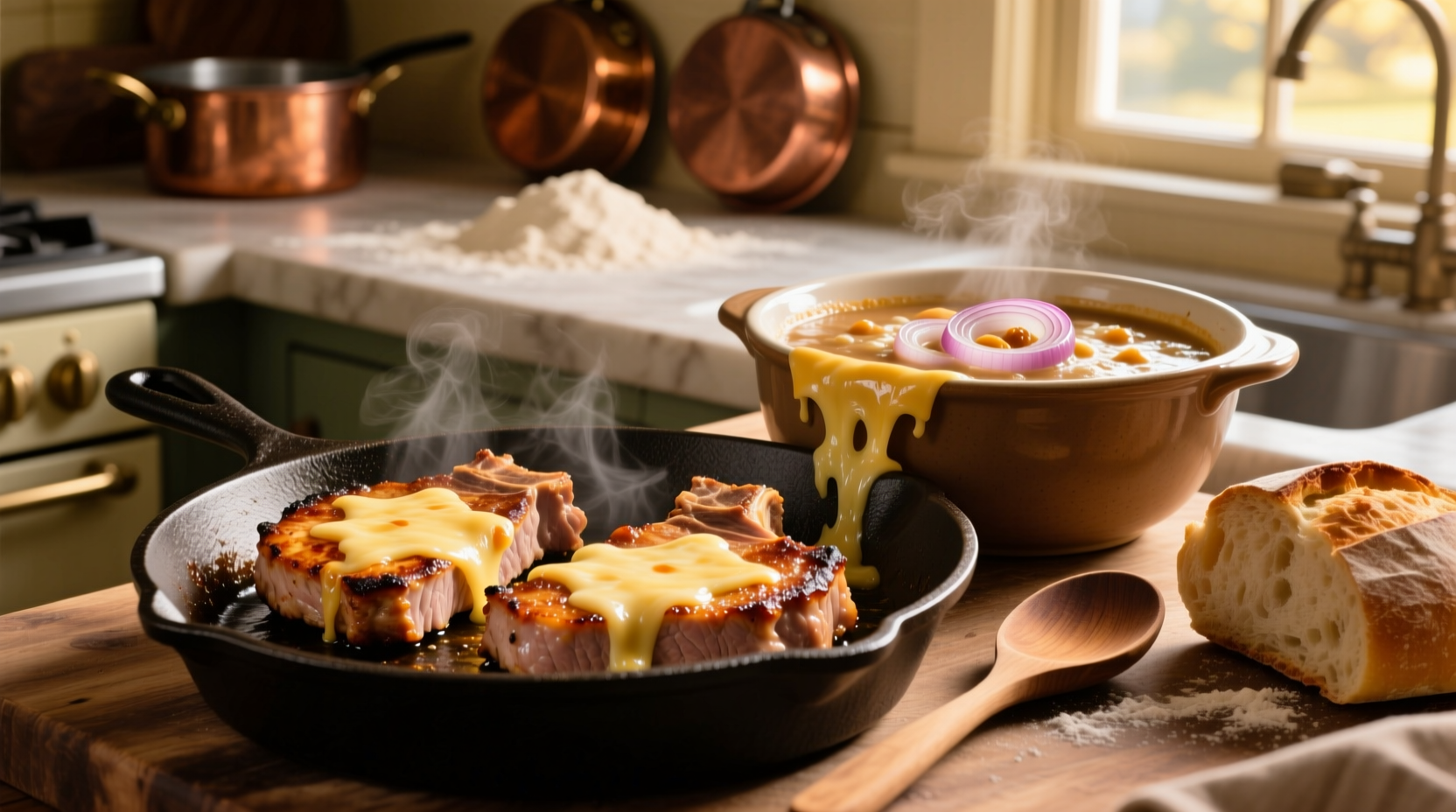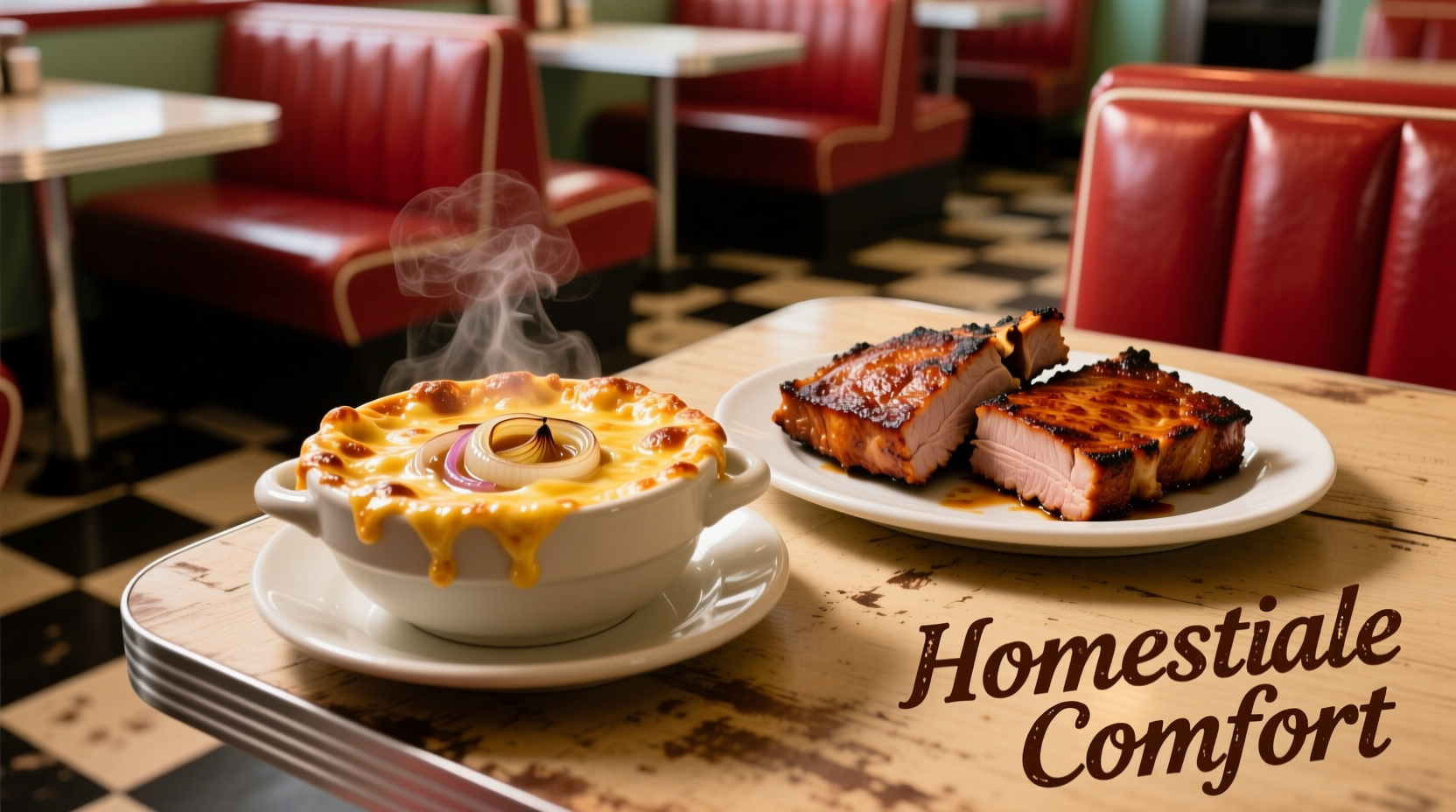The Timeless Appeal of Pork Chops and French Onion Soup
When you're searching for a satisfying dinner that balances comfort and sophistication, few pairings rival pork chops with French onion soup. This combination isn't just delicious—it's a study in complementary flavors that have stood the test of time. The natural sweetness of properly cooked pork chops harmonizes beautifully with the deeply caramelized onions and rich beef broth of authentic French onion soup.
Why This Classic Pairing Works
The magic happens through flavor chemistry. Pork contains high levels of glutamates that enhance savory perception, while French onion soup's slow-caramelized onions develop natural sugars and complex Maillard reaction compounds. When served together, these elements create what food scientists call flavor layering—where each component elevates the other without competing.
| Component | Key Flavor Compounds | Temperature Range | Pairing Benefit |
|---|---|---|---|
| Pork Chops | Glutamates, Inosinate | 145°F (63°C) | Amplifies savory perception |
| French Onion Soup | Fructose, Sucrose, Glutamates | 160-180°F (71-82°C) | Creates sweet-savory balance |
Historical Connection: A Culinary Timeline
While not originally served together, both dishes share fascinating histories that explain their perfect compatibility:
- 18th Century: French onion soup emerged as a peasant dish in Paris, using readily available onions and stale bread
- Early 1900s: American cookbooks began featuring pork chops as an affordable protein option
- 1950s-60s: Post-war American dining culture embraced "continental cuisine," pairing simple meats with European-inspired sides
- 1980s: Restaurant menus across the US began featuring this combination as a "bistro classic"
Mastering French Onion Soup: Essential Techniques
The foundation of this meal is properly executed French onion soup. Many home cooks rush the critical caramelization step, resulting in bitter or one-dimensional flavor. Follow these professional techniques:
The Caramelization Process
True caramelization requires 45-60 minutes of patient cooking. Start with 4 lbs of yellow onions, thinly sliced. Cook over medium-low heat with 3 tbsp butter and 1 tbsp olive oil. The USDA recommends maintaining temperatures below 300°F (149°C) to develop complex flavors without burning. Add 1 tsp sugar after 20 minutes to accelerate the Maillard reaction.
Broth Selection Matters
For authentic flavor, use a combination of beef and chicken broth (3:1 ratio). The American Culinary Federation notes that pure beef broth can overwhelm the delicate onion flavor, while chicken broth adds necessary depth without dominating. Add 1 cup of dry white wine after caramelization for acidity that balances richness.

Perfect Pork Chop Preparation
While the soup simmers, prepare your pork chops using these chef-tested methods:
Selecting the Right Cut
Choose bone-in, center-cut loin chops at least 1¼ inches thick. According to the National Pork Board, these cuts maintain moisture better during cooking. Avoid lean tenderloin chops for this pairing—they lack the fat content needed to complement the rich soup.
Dry-Brining for Maximum Flavor
Season chops with ½ tsp kosher salt per pound 24 hours before cooking. This process, documented in Modernist Cuisine, allows salt to penetrate deeply while improving moisture retention. Just before cooking, pat dry and add freshly cracked black pepper.
Cooking to Perfect Temperature
Heat a cast-iron skillet over medium-high until shimmering. Sear chops 3-4 minutes per side until golden brown. Finish in a 400°F (204°C) oven until reaching 145°F (63°C) internal temperature—the safe minimum recommended by the USDA Food Safety and Inspection Service. Rest for 5 minutes before serving.
Common Mistakes to Avoid
Even experienced cooks make these critical errors when preparing this classic pairing:
- Rushing onion caramelization – Properly caramelized onions should be deep golden brown, not merely softened
- Using pre-shredded cheese – The anti-caking agents prevent proper melting for the traditional cheese crust
- Overcooking pork chops – Even 5 minutes past 145°F causes significant moisture loss
- Serving soup too hot with pork – Allow soup to cool slightly (160°F/71°C) so it doesn't overcook the pork when served together
Serving Suggestions for Maximum Enjoyment
For the authentic bistro experience, serve the pork chop resting on a slice of toasted baguette, with the French onion soup in a separate bowl. Alternatively, place the cooked chop directly into the soup bowl just before adding the broth and cheese—this technique, used in many Parisian bistros, allows the pork's juices to enrich the soup.
Pair with a medium-bodied red wine like Pinot Noir or a crisp lager to cut through the richness. The American Dietetic Association notes that the moderate fat content in this meal makes it suitable for balanced eating when portion-controlled.
Storage and Reheating Guidelines
Store components separately for best results. The soup maintains quality for 4 days in the refrigerator or 3 months frozen. Pork chops are best reheated using the sous vide method at 130°F (54°C) for 30 minutes, though a low-temperature oven (275°F/135°C) works well too. Never reheat pork chops in the microwave, as this destroys texture.











 浙公网安备
33010002000092号
浙公网安备
33010002000092号 浙B2-20120091-4
浙B2-20120091-4